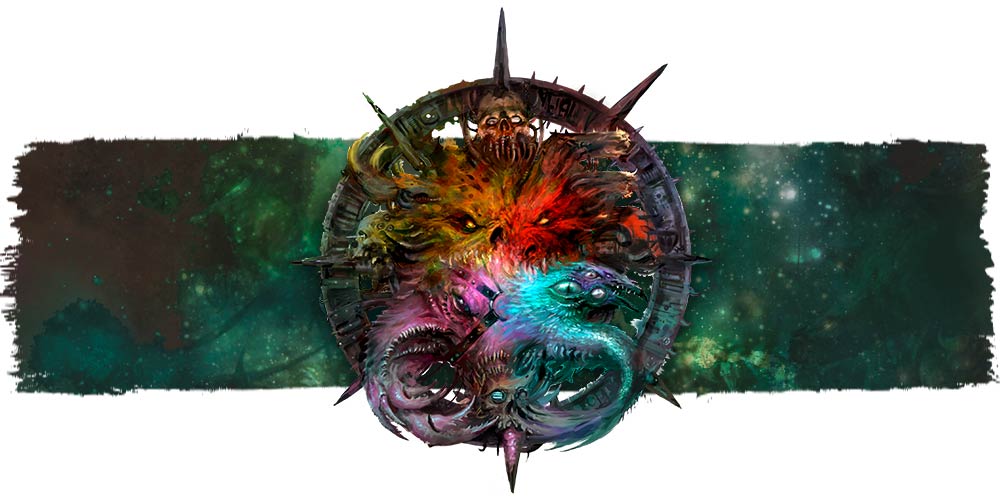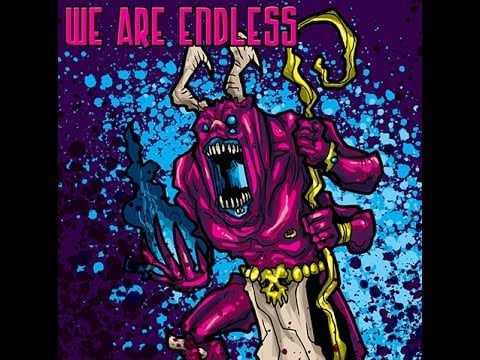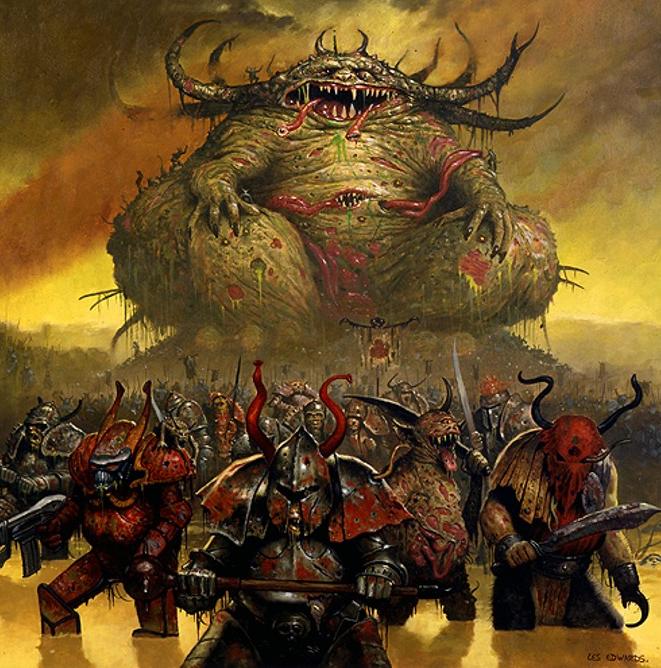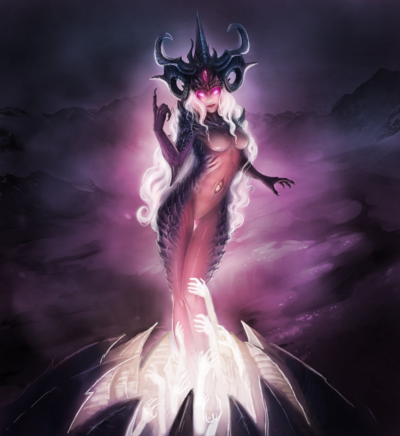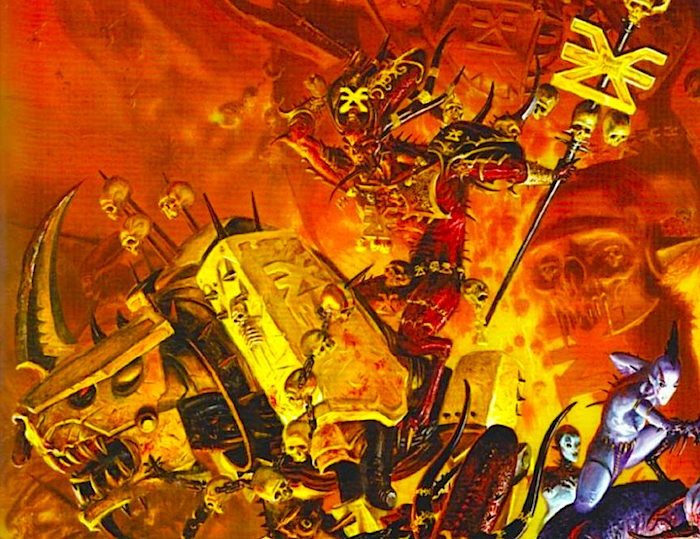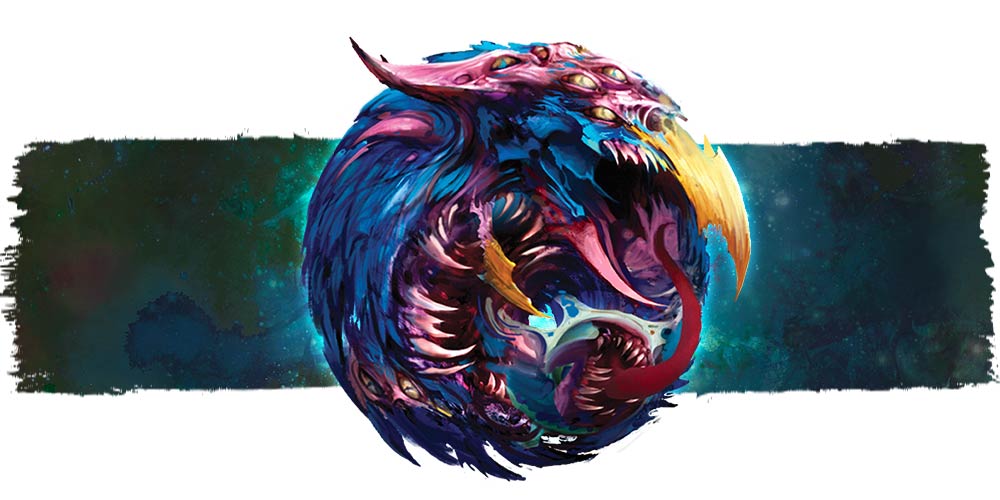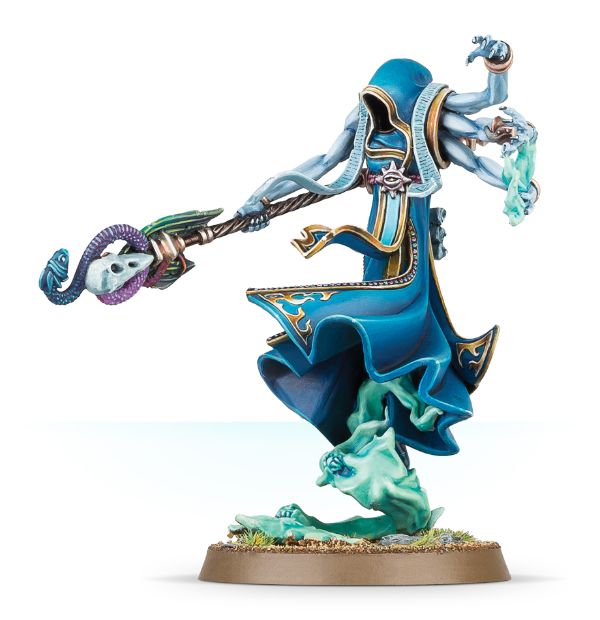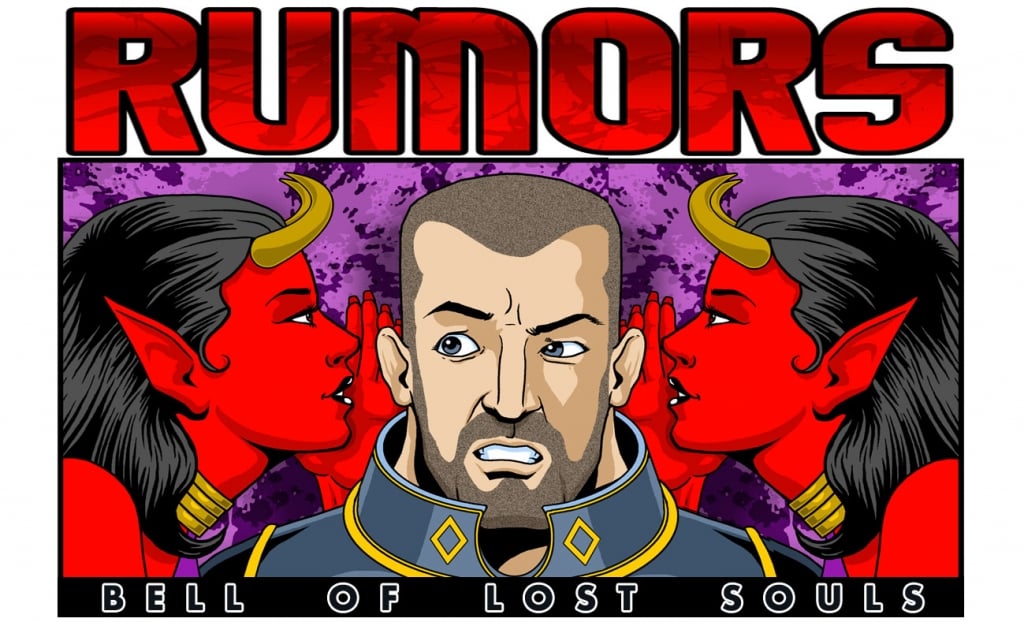40K: Summoning Daemons – Obsolete or Useful?

If you’re a Chaos player like myself, since 8th edition Warhammer 40,000 dropped, you’ve had to wonder — is the Daemonic Ritual (summoning daemons) mechanic even worth it anymore?
The Big Question
Believe me, since the new edition dropped, I’ve asked myself the question many times. After all, considering the rampant free daemon units available via summoning in 7th edition, switching to a system that requires me to not only pay up front for these units, but also requires that I not move the character that performs the ritual and that I make a ‘successful’ roll to perform it, came as quite the shock. To make matters worse, the Daemonic Ritual roll is inherently dangerous, and is likely to harm my character if I’m serious about summoning what I want. All in all, the mechanic seemed more trouble than it was worth (and I heard many voices upon the Great Internet Ocean that shared the sentiment), and I all but abandoned the idea in favor of just building my army in full and settling for a few well-placed uses of the Denizens of the Warp stratagem to deepstrike units in. Don’t get me wrong, I know that 7th edition’s ‘free daemons’ was wrong, and that something needed to be done, but I just felt this was too much.
We are not coming in Peace.
And the Answer Is…
But I’m here to tell you my fellow heretics — I was wrong. The new Daemonic Ritual mechanic is fine; it’s my thinking that was blasphemous. You see, like so many things regarding 8th edition, it was my inability to let go of the past that was really holding me back. Time and again I’ve caught myself doing stupid stuff based upon assumptions of the past. The rules really aren’t that long, and I keep shackling myself with assumptions that just aren’t true any more. So it was with summoning daemons in 8th edition. Sad to say, it took me some time to see the light, and was really only luck (or perhaps the guiding hand of Tzeentch) that opened my eyes.
Not so much any more…
Trafficking with the Ruinous Powers
So how did I see the light? Well, I took a circuitous and scenic route. Basically, before the Great FAQ of the recent past, I found myself in need of more and more opportunities to deepstrike daemon units in (both to counter the rise of alpha striking in the game and to provide mobility to my daemonic hordes). This, coupled with the fact that I like to take a generous helping of Hellforged Artefacts, meant that all my command points were being drained before the army ever saw the table. I found this quite sad, as I feel a lot of an army’s aesthetic feel in 8th edition comes from the various thematic stratagems it can play over the course of a game. It was while lamenting this fact that I began to wonder if I might use summoning to claw back a few command points. So I looked again at the Daemonic Ritual mechanic and began to really think about it. I tried to visualize how I might harness this mechanic to help me regain a little flavor. Gradually, it dawned on me that I was doing everything wrong. I was literally stripping away a distinctive aesthetic element of the Chaos Daemons army (and, indeed, all the Chaos armies) by turning my back on the mechanic.
I felt shame. And then gave myself over to the warm, loving embrace of the Ruinous Powers once more.
 Rare footage of Daemonic Ritual being performed.
Rare footage of Daemonic Ritual being performed.
Summon Daemons — It’s Okay
So what exactly does ‘changing my thinking’ regarding Daemonic Ritual mean? Well, first off, upon really examining the mechanic, I found that the risks were really all in my head. The chances of a character killing itself, or even hurting itself significantly really are minimal — you need to roll doubles to cause a single mortal wound or triples to cause a d3 mortal wounds (which could then still only be a single wound). Depending upon the number of dice you choose, the chances really are in your favor — especially against triples. Then, given the fact that unlike in previous editions of the game, characters all seem to have at least 4 Wounds, who really cares? Your character just isn’t likely to die. Then there’s failure to consider. Here too, the problem was mostly in my head. With the ability to choose to roll three dice, unless I’m trying to summon a greater daemon (and I shouldn’t, but we’ll cover that later), I’m likely to roll a number I can work with.
The second major preconception regarding Daemonic Ritual that I needed to discard is just who can use it, and when. Having played 7th edition so long and utilized its Summoning Daemons rules so much, I just had this built-in idea that psykers summon daemons, but no more. Once again, this preconception block stymied my thinking. Now, any Chaos character (having the keyword) can do it, and since it’s not a psychic power, it cannot be denied. With a bit of thinking, this opens a myriad of strange options — Bloodthirsters, Karanak, Exalted Flamers, the Masque of Slaanesh, Renegade Commanders, even Kharn the Betrayer can all summon daemons. And the list goes on and on. The fact is, my brain just never considered that some of these characters could even have the ability, but they do. And it changes everything. The second part is a bit trickier — the ‘when,’ because that means the character cannot move during the Movement phase. But, again, when you really think on this one, you can make it work for you. Though the inclination is always to move all your units, especially towards the enemy on the first turn, this often isn’t necessary (at least not for everyone). Certain characters don’t want to move often at all — Renegade Commanders, Changecasters, the Changeling, Epidemius, etc. These are perfect characters to utilize Daemonic Ritual to summon allies. But any Chaos character might do, particularly later in the game when they are exactly where they want to be or they’re already engaged in melee and can’t move anyway.
Summoning the masses.
Order Your List to Master Chaos
The last and perhaps most important preconception I needed to rid myself of regarding the use of Daemonic Ritual was in how I used it during army construction. When 8th launched, I disdained summoning daemons, but was just too stubborn to give it up entirely, so I’d always dedicate perhaps 50-100 points to maybe summon a unit of something sometime during the battle. Turns out, this is exactly the wrong sort of thinking. If you’re running a Chaos Daemons army, you should dedicate at least 300-400 points to summoning daemons via Daemonic Ritual and set them aside. If the battle is 2,000 points or more, I’d raise this to 500-600 points or even more. But, and this is key, do not fall into the trap built into the Daemonic Ritual rule itself. Sure, you can summon anything, depending upon the roll, and this seems to offer the bounties of versatility. But it’s a lure of the Chaos Powers, and leads to indecision (slowing the game down) and the temptation to lug around every conceivable combination of daemons with you everywhere (carrying around a full army is tough enough). No, turn from temptation and hold to discipline. Instead of embracing the panoply of Chaos and the awesome utility of it all, instead just treat these summoning points as another part of your army — ‘pre-buy’ the units and set them aside as optional units you know you will summon during the game.
Now just wait right here while I call my girlfriends…
This was a difficult concept for me to embrace at first. When I first read the Daemonic Ritual rule, the versatility allowed by the roll seemed the only good thing about it. But by just treating this summoning reserve as another portion of your army, you avoid a lot of headache and benefit greatly. I highly recommend you keep units held in the summoning reserve to no more than 10 power level (allowing them to be reasonably reliable to summon on 3 dice). In addition, think about the roles these units play. Certain units are just better summoned (in my view) than deployed on the table at the beginning of the battle. Daemonic chariots in particular are good choices, as they are large juicy targets when deployed at the beginning of a battle and so draw a lot of fire that they just can’t stand up to. If summoned, they can be better deployed to avoid such fire (and perhaps dish out some of their own) and are less prone to being shot off the table as the opponent is now likely dealing with other threats. Aside from chariots, I like to summon units that can immediately fire (pink horrors, flamers, plague drones, etc.) or that are slow and probably can’t reach the enemy by walking there (bloodletters, plaguebearers, heralds on foot, etc.).
Snorts and bellows of steam. I feel a herd of friends comin.’
Schemes of the Malevolent
Ultimately, the best way to think of the Daemonic Ritual mechanic to summon daemons is as an extension of the army-wide rules Chaos Daemons dealt with when they first hit the scene back in 6th edition. Back then, you built your army and then split it into two parts of equal numbers of units. Instead of setting up in deployment, one half of your army deepstruck in on turn one and then the rest came in as deepstriking reserves as normal starting turn two. Now, between Daemonic Ritual and stratagems like Denizens of the Warp, we Daemon players can still invoke this sense of our units coming from everywhere and appearing from beyond the veil at any moment. No other army has this ability — though other Chaos armies can borrow it.
Bring forth the Tentacles!
But utilizing Daemonic Ritual to it’s fullest requires discipline and planning. You must always be aware of the restrictions (character cannot have moved and units must be placed with 12″ of the him and more than 9″ from enemies) and make sure you don’t get so caught up in the action that you miss an opportunity. Really getting the most out of summoning requires cunning and plotting and scheming — so think like daemons should. Plan ahead. Utilize the ideas I laid out earlier to avoid confusion and indecision. Once you do, it frees up your mind for more diabolical ploys, allowing you to still get off the necessary deepstrikes, horde all your sinister toys (artefacts) and still have enough command points to use the really nasty stratagems, like Warp Surge and Daemonic Pact (a stratagem I formerly disdained, but now view as great for deploying multiple units from my ‘summoning reserve’ using only one character).
Okay, boy do I have a conundrum for you.
A Chaos Conundrum
Once you embrace Daemonic Ritual and get yourself in the right frame of mind, you’ll find that the Chaos Daemons army is far more mobile and maneuverable than you thought — even with lots of infantry. Then the wheels within the wheels start turning. You can technically defy the Great FAQ by summoning daemon units outside your own deployment zone using Daemonic Ritual. Only up to the 12″ summoning limit to be sure, but it might be enough to catch the unwary by surprise. Ploys and plots. There’s plenty to think on. As a last example, think on this. The new FAQs specifically say that you can re-summon a unique, named character after he’s been slain (this is found in the new CSM FAQ). But what happens if he’s your warlord? If, as the example states, I re-summon the Changling, but he was my warlord, does he return as the warlord? If it matters, does my warlord not count as slain for scoring purposes? I don’t know. I couldn’t find an answer. If pressed, I suppose I would say he returns as the warlord and counts as not slain, as he’s a unique character after all. Further, can I summon him again if he is again slain and I still have points? I assume so, but again, I’m not sure.
~So what do you think? Is the Changling the unkillable warlord? Do you now have a better understanding of and new diabolical plans for Daemonic Ritual? Or perhaps I’m just slow and unworthy and all the rest of the Chaos followers are laughing at me… Share with us in the comments below.
Read more from Kazzigum on Slaved to Ruin

